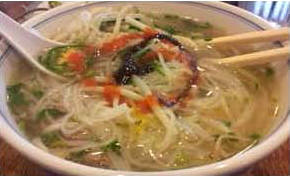The battle of the soups: Pho Hoa vs. Gom Ba Woo
 |
| The pho at Pho Hoa |
opposite corners. But in Annandale two small, opposing restaurants known for
their soup, have shared the same corner, overlooking Columbia Pike at Tom Davis
Drive for years. To the left is Pho Hoa (7133-B Columbia Pike), a Vietnamese noodle soup
specialist that ladles out piping hot bowls of phở (roughly pronounced as “fuh”), an aromatic soup with rice
flour noodles, your choice of meat, and fresh do-it-yourself trimmings.
Phở , a popular fast
food in southeast Asia, arrives tableside with a platter of bean sprouts, green
hot chili peppers, fresh leafy herbs, and lime wedges. Each diner has his or
her own ritual of adding, shredding, or squeezing each garnish into their bowl
while the broth is still too hot to handle. Don’t forget the piquant chili
(Sriracha) and sour hoisin sauces if so inclined, either mixed into the broth
or as a dip for the meats.
Pho Hoa is
actually a multinational franchise, and the Annandale franchiser, open ’til
midnight, dishes up some of the cheapest phở in town.
To the right is Gom Ba Woo (7133-C Columbia Pike), a homey Korean kitchen
known for an ox bone soup called seolleongtang
(pronounced “sul leung tahng” and spelled “sulrangtang” on the menu).
 |
| Seolleongtang at Gom Ba Woo |
white-colored and somewhat bland broth and is served with a bowl of white rice
and seasonings of salt, spicy hot chili paste, and green onions provided
separately so the diner may adjust the soup to her or his own taste. Like most
Korean restaurants, a complimentary assortment of side dishes (called banchan, pronounced “pahn chahn”) is
provided with any meal. If you’re not down
with seolleongtang, or you’re
new to Korean soups, you may want to try galbitang
(pronounced “kahl bee tahng”), either the non-piquant regular or Gom BaWoo’s spicy hot red version. Regular galbitang
is somewhat similar to seolleongtang
but has a mild, clear broth and tender beef short ribs (including bone).
Gom Ba Woo’s spicy hot maeun galbitang
looks like a red version of the regular but doesn’t pique the tongue as
much as, say, the medium spicy level at the nearby Lighthouse Tofu.
(although phở comes optionally
with chicken or seafood). Both are traditionally long simmered with beef bones,
both come with do-it-yourself garnishes, and neither are served spicy hot,
although the diner can spice them up with the condiments provided. Both may
involve cuts of meat less common in American cuisine, such as tendon and tripe.
 |
| Maeun galbitang at Gom Ba Woo |
chef, so if you’re picky about what part of the cow you’ll eat, talk to your
server before ordering if the menu isn’t revealing on the matter. Phở is primarily a noodle soup,
whereas seolleongtang may
involve some sweet potato noodles but comes with white short-grain rice on the
side. When it comes down
to the restaurant, Pho Hoa has a slight dinner price advantage but does not
serve extras, like side dishes. Gom Ba Woo, in addition to soups, has a full
menu of other popular Korean foods (surprisingly for a restaurant so small),
whereas Pho Hoa serves, in addition to phở ,
a few rice dishes, spring rolls, Vietnamese coffee, and bubble tea. But the
deciding factor comes down to what kind of soup you want. Each soup may have
its partisans, but the long and continuing coexistence of these two kitchens
next door to one another is a testament to soup, not as winner-take-all
politics, but rather as a feature of the community’s culinary mosaic. So, as
long as beef stock soup is what you want, this corner of Annandale has you
covered.

